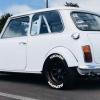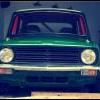Another thing to think about, if the rear end lets go on a Mini, is having the tracking checked. You now need to do that anyway, after repairs. If the rear wheels are not correctly toed in, and slightly toed out instead, the degradation in handling is truly amazing. The rear end suddeny has a mind of its own, instead of being generally well-behaved.
As for tyres, they "should" be much better nowadays than the crossplies that Issigonis had to work with, the exception being the vile, and even dangerous junk that floods the market from various places including Eastern Europe and China. Some of them get into the country as tyres for agricultural trailers, which is all that they are fit for, and are sold by the unscrupulous as being fit for cars. I don't know if anyone on this forum has been caught out by these, but they are certainly around in larger sizes.
But, always, the laws of physics dictate that in the wet, wider is not helpful. However, it is fair to say that a SLIGHTLY wider than standard tyre may give a little bit more dry grip, and if the tread pattern has been radically improved, and the water clearance is better, it "may" be better than a 1959 type narrow tyre in the wet. Actually it "will" be better, because nowadays it will be a radial tyre, and that change makes far more difference than just about anything else, if the suspension design suits radials, which it does on the Mini. However, my earlier general comment about avoiding excessive width is still true. 195s on a MGB are not excessively wide, possibly optimum, with today's technology, and Uniroyals are better than most at water clearance. If only we could get those on Minis, where the variety of decent tyres available is far less than it used to be.
There is however another thing to consider. The dry grip of a crossply may actually be about the same as a radial, using the same rubber compound, but only right at the limit, where understeer becomes a front wheel skid. Below the limit, the greater slip angle of crossplies means more understeer, which means more tyre wear and power loss, also more heat build-up in the tyres, but the understeer comes in ever so slowly and progressively as the speed rises (as does the lift-off oversteer) that even a complete idiot would find it hard to crash a crossply-equipped Mini. You can drive a radial-equipped car harder, but it bites more suddenly. Negative camber, it understeers even less, and bites even more suddenly, which is why only a modest amount of negative is needed for most drivers. My only ever major crash was in a Vauxhall Viva HA equipped with the then quite new Michelin X tyres, said to be the best thing since sliced bread. In fact, as I now know, their wet grip was mediocre, and they were prone to sudden breakaway on damp roads, which is precisely what they did. Their only good quality was that they lasted twice as long as crossplies. But as a 17 year old I new none of that.....



















